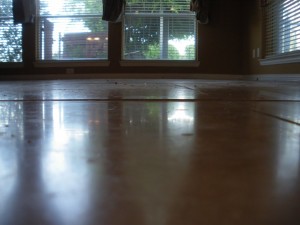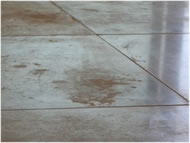Travertine Restoration
HAS YOUR TRAVERTINE LOST ITS LUSTER?
Travertine is characterized by winding, irregular holes in the surface, with the flats finished to varying degrees of smoothness and reflectivity. “Shell Stone” is another type of this same material with shells embedded.
Travertine has undeniably become more and more popular in the past few years. With that popularity there have been corresponding problems. Some relate to installation, while others are an inferior grade of stone and there remains the ever present failure to use the proper stone cleaning process and product. Take a look at our Stone Blog for some common sense caveats for care and maintenance.
Travertine Restoration:
The characteristic voids in Travertine were caused by gases present when the rock was in the molten state. These voids appear as holes in the tiles and are either filled during the fixing process or at the Factory. Orlando Travertine Restoration’s restoration process may involve filling an entire floor or random tiles that have these voids. The fill is either a form of grout or an epoxy resin filling. Our craftsmen also perform crack repairs, grout repairs, grout restoration for soiled grout all of which is done based on the level of restoration your particular surface requires and the finish you desire. Orlando Travertine Restoration uses the latest state-of-the-art equipment, diamond abrasives and other tools to restore your surfaces to like new again.
Travertine Restoration Grinding:
Using the highest impact abrasives (lowest grits) this method is designed to remove a measurable amount of stone. Uneven tile edges (lippage) can be evened out using this method. Depending on the density of your stone and severity of lippage, our grinding process and state-of-the-art machinery is the most efficient available.

Left: Example of “lippage” or uneven edges. High edges can be ground down using abrasives… with caution.

Right: Example of poor grinding on Travertine: Excessive and uneven grinding technique resulted in wavy stone and also opened up large pits. *This grind was not done by our company.*
Travertine Etching:
Travertine, Marble and Limestone are all subject to etching. Etches are small scratches that create a dull spot on the stone. Mostly caused by spills containing any type of acid: Citrus, wine, alcohol, vinegar, pet accidents all contain acids. Acid eats calcium carbonate found in these stones and the result is an etch. The natural chemical reaction is almost immediate and can vary in severity depending on acid level, how long it sits, and the size. Penetrating sealers guard against the acid from eating through layers of the stone, thereby keeping the etch on top so it can be buffed out again during regular professional maintenance.

Example of large etches on Travertine. Acidic and/or abrasive cleaning agents and methods will also cause etching. Stick to soft cleaning cloths with a neutral stone cleaner.
(Abrasives and techniques will vary according to grade, density, porosity and installation of the stone. Travertine, Marble and Limestone have different characteristics, use different approaches, and provide varying results
due to being a naturally occurring product)
Satin Glow Finish:
A soft subtle sheen for a clean and uniform look. Rids the stone of the dull chalky appearance so common with newly installed Travertine.
There are many different types of stone available today. When stone is ordered, it is fabricated with a particular type of surface. There are six main type of surfaces that are selected:
Honed: Provides a flat to low sheen gloss. Different levels of gloss can be selected. This surface is very smooth, but often very porous. This texture is common in high traffic buildings. Honed travertined floors should always be protected with Penetrating Sealer because it has wide-open pores. Honed stone colors are not as vibrant as polished stone.
Polished: A glossy surfaces that wears away with time due to heavy foot traffic and using improper maintenance procedure. This surface is very smooth and not porous. The reflectively of polished crystals brings out the brilliant colors and grains of natural stone. The shine comes from the natural reflection of the stone’s crystals. The shine is due to polishing bricks and polishing powders used during fabrication. The Shine is not from a coating.
Sand Blasted: This surface is the result of a pressurized flow of sand water that provides a textured surface with a matte gloss.
Bush Hammered: A pounding action that develops a textured surface. The degree of roughness can be selected.
Regardless of the type of surface to be maintained, all stone should be protected with sealers.
Flamed: A rough surface that is developed through intense heat. During fabrication, the stone is heated up and the crystals begin to pop, thus forming a rough surface. This surface is very porous and must be treated with Stoneguard.
Tumbled: A slightly rough texture that is achieved by tumbling small pieces of travertine, limestone, and sometimes granite to achieve an archaic/worn appearance. It often requires an application of Stone Color Enhancer to bring out the colors.
Sawn: A process performed by using a gang saw.
Give Orlando Travertine Restoration a call today at (407) 279-3739.






